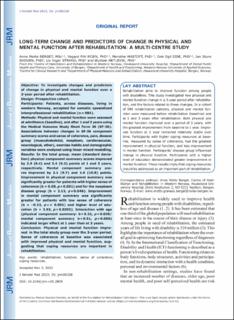| dc.contributor.author | Berget, Anne Mette Gravaas | |
| dc.contributor.author | Moen, Vegard Pihl | |
| dc.contributor.author | Hustoft, Merethe | |
| dc.contributor.author | Eide, Geir Egil | |
| dc.contributor.author | Skouen, Jan Sture | |
| dc.contributor.author | Strand, Liv Inger | |
| dc.contributor.author | Hetlevik, Øystein | |
| dc.date.accessioned | 2023-04-12T09:38:52Z | |
| dc.date.available | 2023-04-12T09:38:52Z | |
| dc.date.created | 2023-01-05T11:17:46Z | |
| dc.date.issued | 2023 | |
| dc.identifier.citation | Berget, A. M., Moen, V. P., Hustoft, M., Eide, G. E., Skouen, J. S., Strand, L. I., & Hetlevik, Ø. (2023). Long-Term Change and Predictors of Change in Physical and Mental Function after Rehabilitation: A Multi-Centre Study. Journal of Rehabilitation Medicine, 55:jrm00358. | en_US |
| dc.identifier.issn | 1650-1977 | |
| dc.identifier.uri | https://hdl.handle.net/11250/3062577 | |
| dc.description.abstract | Objective: To investigate changes and predictors of change in physical and mental function over a 3-year period after rehabilitation.
Design: Prospective cohort.
Participants: Patients, across diseases, living in western Norway, accepted for somatic specialized interprofessional rehabilitation (n = 984).
Methods: Physical and mental function were assessed at admittance (baseline), and after 1 and 3 years using the Medical Outcome Study Short Form 36 (SF-36). Associations between changes in SF-36 component summary scores and sense of coherence, pain, disease group (musculoskeletal, neoplasm, cardiovascular, neurological, other), exercise habits and demographic variables were analysed using linear mixed modelling.
Results: In the total group, mean (standard deviation) physical component summary scores improved by 2.9 (8.4) and 3.4 (9.3) points at 1 and 3 years, respectively. Mental component summary scores improved by 2.1 (9.7) and 1.6 (10.8) points. Improvement in physical component summary was significantly greater for patients with higher sense of coherence (b = 0.09, p = 0.001) and for the neoplasm disease group (b = 2.13, p = 0.046). Improvement in mental component summary was significantly greater for patients with low sense of coherence (b = –0.13, p = < 0.001) and higher level of education (b = 3.02, p = 0.0302). Interaction with age (physical component summary: b = 0.22, p = 0.039/mental component summary b = 0.51, p = 0.006) indicated larger effect at 1 year than at 3 years.
Conclusion: Physical and mental function improved in the total study group over the 3-year period. Sense of coherence at baseline was associated with improved physical and mental function, suggesting that coping resources are important in rehabilitation. | en_US |
| dc.language.iso | eng | en_US |
| dc.publisher | Medical Journals Sweden | en_US |
| dc.rights | Navngivelse-Ikkekommersiell 4.0 Internasjonal | * |
| dc.rights.uri | http://creativecommons.org/licenses/by-nc/4.0/deed.no | * |
| dc.title | Long-Term Change and Predictors of Change in Physical and Mental Function after Rehabilitation: A Multi-Centre Study | en_US |
| dc.type | Peer reviewed | en_US |
| dc.type | Journal article | en_US |
| dc.description.version | publishedVersion | en_US |
| dc.rights.holder | © 2023 Anne Mette Berget, Vegard Pihl Moen, Merethe Hustoft, Geir Egil Eide, Jan Sture Skouen, Liv Inger Strand, Øystein Hetlevik | en_US |
| dc.source.volume | 55 | en_US |
| dc.source.journal | Journal of Rehabilitation Medicine | en_US |
| dc.identifier.doi | 10.2340/jrm.v55.2809 | |
| dc.identifier.cristin | 2101153 | |
| dc.source.articlenumber | jrm00358 | en_US |
| cristin.ispublished | true | |
| cristin.fulltext | original | |
| cristin.qualitycode | 1 | |

